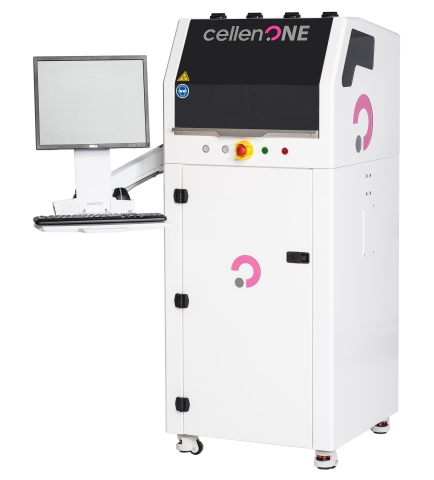BILLERICA, Mass.–At the virtual 20th Human Proteome Organization World Congress, HUPO Reconnect 2021 (hupo2021.org) Bruker Corporation (Nasdaq: BRKR) announced major advances in collision cross section (CCS) enabled 4D proteomics workflows on the unique timsTOF multiomics platform.
Dr. Gary Kruppa, Bruker’s Vice President for Proteomics, stated: “Widespread adoption of proteomics has been limited by complex sample preparation protocols that were not easily automated. We are excited to announce that Bruker is collaborating with industry-leading partners on higher performance, automated workflows in three key areas: single-cell proteomics, plasma proteomics and tissue proteomics.”
A. New Collaboration with Cellenion for 4D Single-Cell Proteomics (SCP)
Bruker announces a co-marketing agreement with Cellenion on the cellenONE single-cell isolation and nanoliter dispensing robotic platform. The partnership with Cellenion on label-free 4D single-cell proteomics (SCP) provides timsTOF SCP users with an end-to-end solution. The cellenONE is a unique single-cell isolation and nanoliter dispensing technology. It enables high-throughput, automated dispensing of individual cells from cell suspensions with its unique advantage of minimal perturbation to the integrity of the live cell. It is also perfectly suited for reagent dispensing, enabling miniaturized sample preparation protocols on those isolated cells.
Dr. Holger Eickhoff, CEO of Cellenion and Scienion, said: “We believe our expertise in precision dispensing and platform technology for up to 100% single-cell isolation accuracy and Bruker’s expertise in developing mass spectrometers such as the timsTOF SCP for single-cell proteomics are a perfect match. This partnership will benefit our mutual users as the cellenONE provides automated single-cell isolation and miniaturized sample preparation using our patented nanoliter dispensing technology.”
B. Collaboration Progress with Seer on Unbiased, Deep Plasma Proteomics
Deep interrogation of the plasma proteome is challenging, because of the wide dynamic range of proteins, making it difficult to detect low-abundance proteins that may serve as biomarkers for disease. Fast plasma proteomics workflows typically detect only hundreds of protein groups, whereas workflows that deplete high-abundance proteins or fractionate the plasma proteins before analysis are costly, time-consuming and do not scale well. The combination of Seer’s Proteograph™ Product Suite and timsTOF platforms allow researchers to dig deeper into the plasma proteome, detecting protein variation at the amino acid level, with an unprecedented combination of depth, scale, and speed to power discovery. “The Proteograph is providing access to the plasma proteome in a way that has just not been possible before,” said Gary Kruppa, Vice President for Proteomics at Bruker. “We are excited about the opportunities that the combination of timsTOF and Proteograph enables.”
“In a recently presented joint study, we demonstrated that the Proteograph™ Product Suite enables quantification of more than 3,000 proteins from a single pooled human plasma sample within only 60 minutes of acquisition time on the timsTOF SCP,” said Dr. Daniel Hornburg, Sr. Director, Discovery Research and Tech Development at Seer. “We’ve seen excellent performance of the timsTOF Pro in our labs and the timsTOF SCP as part of the collaborative work with Bruker. The timsTOF Pro and SCP coupled with our Proteograph provide sensitivity that takes plasma proteomics to the next level.”
C. Expanded Partnership with PreOmics on Novel BeatBox™ Technology for Tissue Proteomics
To demonstrate the performance of the innovative BeatBox system for high-throughput tissue homogenization, PreOmics processed a variety of tissue samples on the BeatBox and compared results to those obtained with other commercial homogenization solutions. The protein extracts from the tissue samples were processed using iST proteomic sample preparation and the data was acquired on a timsTOF Pro with 45 minutes total acquisition time using DDA-PASEF. The complete BeatBox-timsTOF workflow from tissue sample to high-quality proteomic data is below 4 hours and can homogenize 96 tissue samples in parallel in 10 minutes. The new BeatBox technology provided the highest protein yields with up to 3x increases and showed very good reproducibility across different tissues in comparison to other homogenization solutions.
The BeatBox-timsTOF Pro workflow resulted in excellent proteomic coverage, e.g., more than 4000 protein IDs for mouse lung and 2300 protein IDs for mouse heart muscle. Drs. Nils A Kulak and Garwin Pichler, Founders and Managing Directors of PreOmics, commented: “We are very excited about our innovative BeatBox technology for highly efficient and reproducible proteomics tissue homogenization. The BeatBox is seamlessly compatible with PreOmics’ proteomic sample preparation technologies and in combination with the timsTOF Pro provides end-to-end workflows for processing of large tissue biobanks.”


